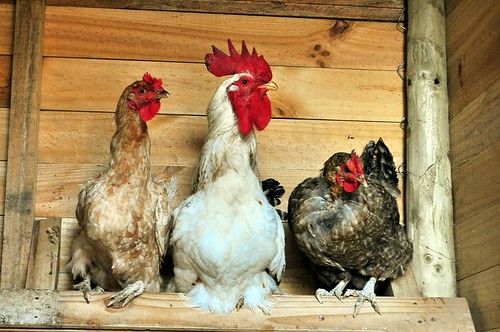If I judge by the interest to our post with chicken coop pictures, it seems that people who are interested in sheds are often interested in chicken coops too. This make sense - most of us are homesteaders. And while a shed can often be used for a coop, I recommend you to learn more about the specific requirements of raising backyard chicken first. It is by itself a large topic, so here we'll only focus on the specific of the coop itself.
Why a Chicken Coop?
Primary reason: to protect them from beasts. Hens often become victims of foxes, coyotes, polecats, dogs, wolves, hawks, rats, and other predators. Almost everywhere in the world there are animals that can and will eat your chicken. Especially in the night when they are sleaping and can't escape. Keeping the chicken into a well fenced area is absolutely a must.
A controversial but important reason is to protect your ladies from cold in the winter, from strong rain and hail. If you are living in a hot place or you prefer to keep your chicken on resh air, you can build or buy one of those well ventilated coops that only protect from the top (rain and sun) and from predators.
Another important reason to have a coop is to protect your garden from the chicken. They will eat and destroy any vegetables and seedlings they find so it's not a wise idea to let them walk freely everywhere in your garden.
The chicken coop can also provide special place for laying eggs, for collecting bird droppings and so on.
So yes, if you plan to raise poultry, having a coop is a must.
Requirements
At the minimum, your chicken coop needs to satisfy the following:
- Your chicken coop must be well protected from predators. Already said, this is the primary reason to have a coop. So make sure nothing can enter inside - from the sides, from the top, and from the bottom. Make sure the mesh is solid and its holes are not too large. Immediately fix cracks in the mesh or the walls.
- It must be well ventilated. Worry less about the cold (chicken are hardy!) and more about bad-air caused diseases.
- Protected from wind. While chicken survive the cold, don't let them chill too much on a windy place. Ventilated does not mean drafty.
- Have a removable droppings tray. Or should I just say "keep it clean".
- Ensure it has enough space. Your girls must feel good. You need from 4 to 10 square feet per bird.
- Ensure roosting poles for laying hens.
- Include feeder and waterer for obvious reasons.
- Good design. OK, this is far from strict requirement but let's not forget the coop is going to stay in your garden. You don't want it to be ugly, do you?
Optionally you may want it to be partly shaded, affordable, to have a green roof, and more. Again, our post with chicken coop pictures can give you plenty of ideas.
Types of Chicken Coops
Most guides online talk about small, medium and large as "types" of chicken coops. This is course doesn't make much sense. There is no real categorization of coops, at least not one that everyone agrees to. However, here are some types worth thinking about:
- The Eglu chicken coop is actually a brand. It's a small portable coop with original design. The official site of the manufacturers is here.
- Poultry shed means actually to adapt a simple garden shed into a chicken coop.
- Plastic coops - most coops are build by wooden boards and mesh (which is well, another "type") but there are some small and cheap options from plastic.
- Portable coop or chicken tractor. Often used to let the chicken graze and fertilize different parts of the homestead.
- Chicken arks that are large and provide open and closed area for chickens that can't freely range for various reason.
I wouldn't recommend you to stick to a specific type. Just build or buy what suits your needs.
DIY Chicken Coops
Speaking about building, how easy it is to build your own coop? A basic chicken coop can be easier to build than a basic shed. Because part of the enclosure can be just a chicken wire mesh, the materials can come cheaper as well. It might be a good idea to buy or download free coop plans. There are many sites selling plans and some excellent free guides like this one for example.
A decent guide giving you an idea where to start and how large coop you'd need is available here.
Buying a Ready Chicken Coop
If you prefer to buy a ready chicken coop, just re-check the requirements from this article and make sure they are met. Of course, good price is also a reasonable requirement. Below are several good chicken coops and coop kits that can be bought online:
Sources and Links
I've read some of the following sites to gain more info and I think you can benefit from them too:
- http://en.wikipedia.org/wiki/Chicken_coop
- http://www.mypetchicken.com/backyard-chickens/chicken-care/chapter-5-chicken-coop-requirements.aspx
- http://www.keepingchickens.com/chicken-coops-requirements/
- http://thepoultryguide.com/different-types-of-backyard-chicken-coops/
- http://www.hobbyfarms.com/livestock-and-pets/chicken-coop-design.aspx
- http://www.themorristribe.com/2011/10/17/how-to-buy-a-chicken-coop/

